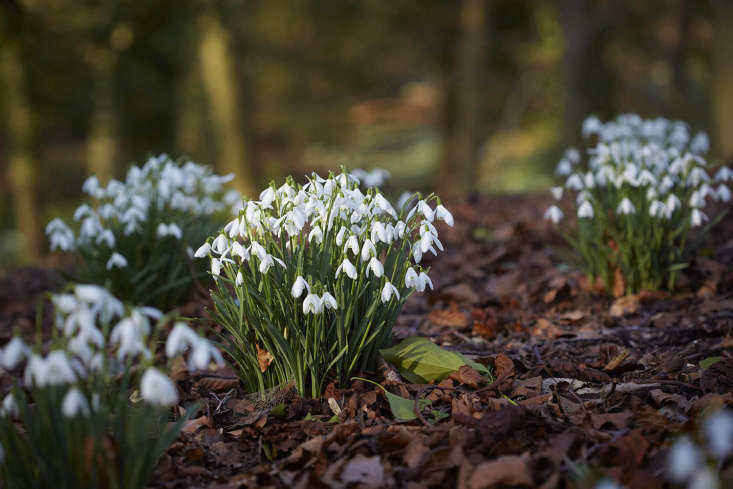I don’t know why the volume of autumn leaves that fell onto our yard that first fall in our new home was such a surprise. We had moved to a town called Maplewood, after all—not to mention what had drawn us to the area was a noteworthy abundance of “grandfather” trees. When the first leaves fell, my husband and I ushered our kids out the door, eager to introduce them to the invigorating pleasures of raking. Look at us! We are raking leaves from our trees in our yard! We are wearing flannel shirts! And our kids are jumping into leaf piles like good suburban poster children!
Our smugness didn’t last long. Just a few days later, our yard was covered again. And we realized that raking would be an every-weekend chore for the rest of fall. (A leaf-blower was out of the question for my manual-labor sentimentalist of a husband.) By the end of the season, we were searching for every excuse not to rake. Didn’t we hear somewhere that covering your garden with leaves is actually beneficial? Isn’t that what real back-t0-the-land gardeners do? We don’t want to be bourgeois about our landscaping, do we?
Ultimately, fear of sticking out in a neighborhood of tidy lawns kept us raking. But with the prospect of another season of leaves, leaves, leaves ahead, I think it’s time to revisit my burning question: What’s so bad about leaving your leaves where they fall?
Featured photograph by John Merkl for Gardenista.

Q: To rake or not to rake, what do the experts think?
A: “I think a landscaper would say rake, because it looks better and it’s more money in their pocket; a gardener would say rake and use as compost or mulch; and a farmer would say leave them and mow them in place because it’s inefficient to move them around,” says Kenneth Hacker, a farmer and local food preserver with Eastern Mass. Provisions Co. (and Kristina’s big brother!).
He’s not shy about sharing his feelings on the great raking debate: With landscaping, “you pay to remove all the organic matter from your lawn, and then pay to fertilize it with chemicals later.” Instead of clearing your yard of leaves, Kenneth suggests pulverizing dead leaves with a lawn mower and spreading the leaf mulch all over your yard and garden to help incorporate it back in the soil.
“I would say there is no absolute best way to manage leaves, because it depends how you view them. If it were my lawn and I wanted it to be healthy with the least amount of work or inputs, I’d leave them and chop them in as I mow,” he says.
Q: What are the benefits of leaf mulch?

A: Leaf mulch has many benefits. A leaf blanket helps prevent weeds, keeps soil from drying out, decreases the risk of erosion, and provides shelter for beneficial organisms. In general, “it’s best to minimize the amount of bare soil exposed in your garden,” says Kenneth. Furthermore, ground-up leaves, left to winter in place, likely will eventually compost into nutrients for healthier soil. (See Transforming Leaves from Trash to Treasure for helpful tips on composting leaves.)
Q: Are all leaves beneficial?
A: We have a pine tree on the side of our house, and I’ve always wondered if the needles that fall are OK to leave (they’re so pretty as ground cover). “Pine needles are often mixed in with deciduous leaves and make a good mulching material too because their shape allows for good water infiltration, like straw,” says Kenneth. “I’d say use whatever is available and abundant for mulch, with only a few rare exceptions. Black walnut comes to mind because it is a tree famous for producing a toxin that inhibits the growth of other plants. I wouldn’t use material from those in my garden.”
Q: Is there such a thing as too much leaf mulch?

A: Kenneth says the optimal method is to cover your garden or lawn with the mulch until you can’t see the ground anymore; then add a little more. (Michelle says about an inch of leaf mulch is ideal.) “It would be hard to add too much mulch unless you were starting to pile up too high around the base of a plant, like lettuce, that is susceptible to rot,” he says. “And rain will still penetrate the mulch as long as you don’t have a thick layer of matted leaves.” Which brings me to…
Q: Can you use whole leaves for mulch?
A: Yes, but if you’re using whole leaves to mulch, stick to a thin layer. Rain and air can get through shredded leaves relatively easily, but that’s not the case with a thick layer of un-shredded leaves. In general, best practice is to shred the leaves. “If you leave a fall’s worth of leaves untouched on your lawn, there’s a good chance they’ll still be there in the spring because they were spread out and dry for a long time [not facilitating decomposition], then frozen through the winter,” says Kenneth. “If you kept on mowing over them though, there’s a good chance the pieces will have made their way through the blades of grass to the soil, where they can be digested by soil-inhabiting organisms.”
For more beginner gardening stories, check out:
- Your First Garden: What You Need to Know About Topsoil
- Expert Advice: 7 Tips to Put Your Garden to Bed for the Winter
- The Garden Decoder: What Is a Cool-Season Crop?












Have a Question or Comment About This Post?
Join the conversation (2)